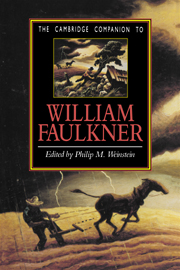Introduction
Published online by Cambridge University Press: 28 May 2006
Summary
What do we do and why when we think Faulkner? This is the personal (but never just personal) question I asked all of the contributors to ponder as they thought about their essays for this Companion. In responding to it, they have aligned their work, roughly, within one of two groups: “the texts in the world” or “the world in the texts.” The five essays that make up Part I explicitly press beyond the art of Faulkner’s texts in order to comment on the larger “world” those texts inhabit, envisaged here as contextual social activities and processes within which Faulkner’s practice may reveal its broader cultural dimensions. These essays sketch out a range of contexts - modernism, postmodernism, the “culture industry,” a canon of twentieth-century European novelists, the noncanonical practice of Latin American fiction of the same period - that permit us to consider Faulkner’s comparative identity. To put the matter differently, these first essays identify several of the current “theaters” in which Faulkner’s texts are most interestingly performed.
The three essays that constitute Part II operate otherwise, probing more deeply into the textual behavior of three of Faulkner’s canonical masterpieces -The Sound and the Fury, Light in August, and Absalom, Absalom! These essays attend in detail to a discrete text’s formal moves, but they go beyond New Critical procedures in their insistent focus on "the world in the texts," especially the larger social problematics of race, gender, and subject formation. A fourth Faulknerian text - Go Down, Moses - receives sustained attention as well, in the essays of Patrick O'Donnell and Warwick Wadlington.
- Type
- Chapter
- Information
- The Cambridge Companion to William Faulkner , pp. 1 - 14Publisher: Cambridge University PressPrint publication year: 1995



